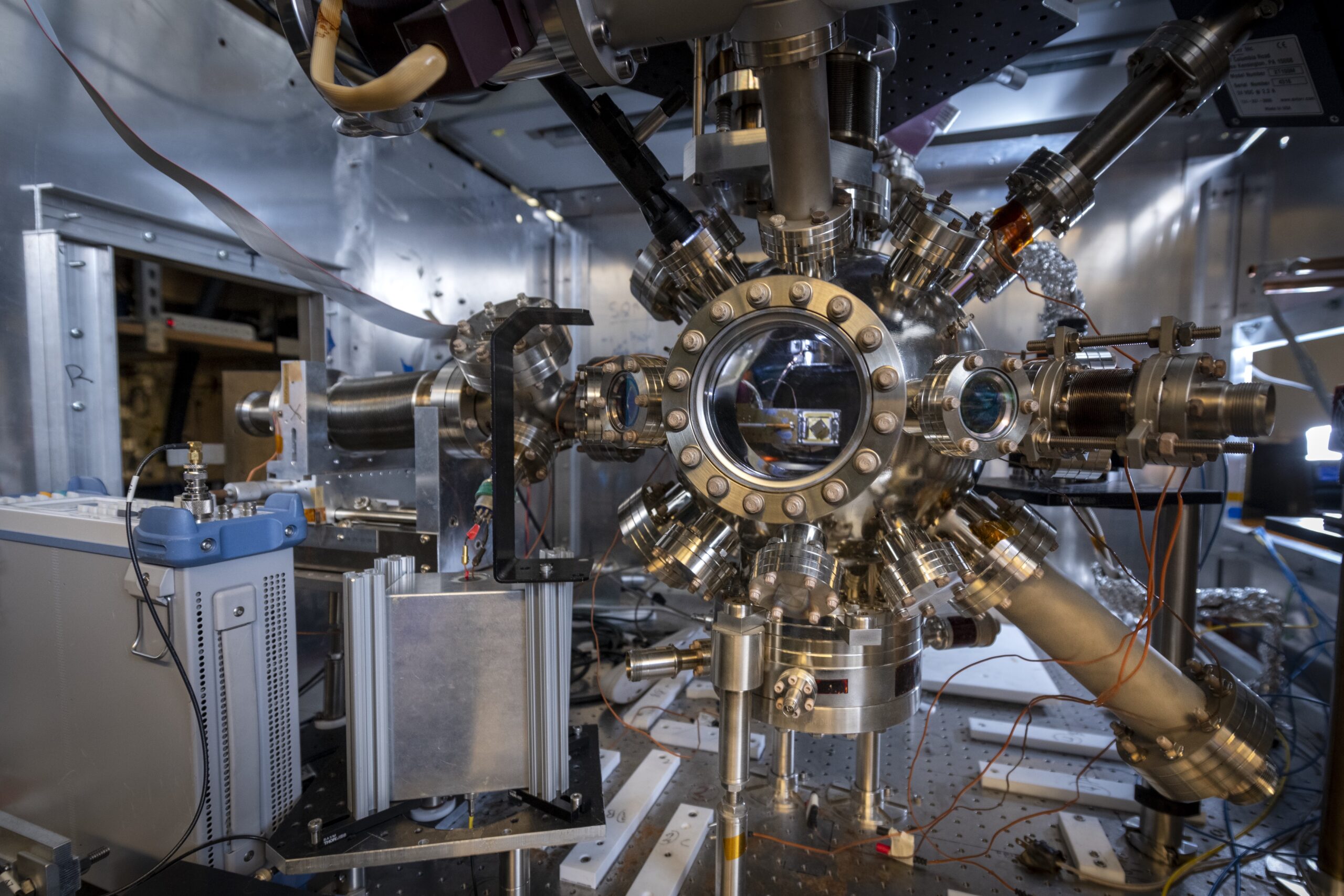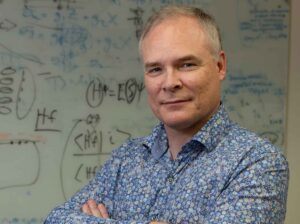Bert de Jong leads the Applied Computing for Scientific Discovery Group at Lawrence Berkeley National Laboratory. He also heads the Advancing Integrated Development Environments for Quantum Computing through Fundamental Research project, a multi-institution effort in open-source computing, programming and simulation for Department of Energy’s Advanced Scientific Computing Research program and has leadership roles in several other DOE-supported quantum information science programs, including as deputy director for the Quantum Systems Accelerator. Before joining Berkeley Lab, de Jong spent 14 years in leadership roles at Pacific Northwest National Laboratory. He earned his doctorate in theoretical chemistry at the University of Groningen.
Now, some terminology: In quantum mechanics, subatomic particles, even far from each other, can experience entanglement – that is, the behavior of one particle can alter the other at distance. Superposition: Particles can exist in multiple states at once until they’re observed. There are different types of qubits, the quantum version of a binary bit. Superconducting qubits are chips constructed with Josephson junctions, structures that weakly link superconductors; current flow between them can produce superposition and entanglement. Trapped-ion and neutral-atom qubits are both trap-based approaches. Trapped ion qubits are held in place by an electric field. Neutral-atom qubits are trapped by tweezers made of light; lasers coax entanglement and rotate qubits between 0 and 1.
ASCR Discovery: How and when did you start working with quantum computing?
Bert de Jong: About eight years ago I realized that classical computers cannot scale forever. We cannot make them smaller; we cannot make them faster. There’s too much energy that we have to put into that. So I started to look more at other computational tools we could use.
Tell us about the Quantum Systems Accelerator.
It’s one of five Department of Energy Office of Science National QIS Research Centers funded to work on quantum research and development as part of the United States National Quantum Initiative. We’re focusing on scaling and building more-accurate quantum computers in three different types of technologies: superconducting qubits, trapped ions and neutral atoms.
We want to understand each platform’s challenges and find commonalities. It’s not just about building better qubits, but also figuring out how to scale them up to many qubits.
On the hardware side, for about two and a half years we’ve been working with a neutral-atom system at the scale 256 qubits. We’ve been able to do real materials science simulations at that scale. With trapped ions, we are now building the first trap that can hold up to 200 ions. If you look at superconducting qubits, we are now in the order of 25. There, it’s not just building more, but also trying to find better ways to control the qubits.
We’re also doing a lot of work on the algorithms and software side. How do you know that you get real quantum advantage with a quantum computer? We have some research programs focused on chemistry and materials, nuclear physics and high-energy physics, trying to understand how we can use these quantum computers to do real science.
What is quantum computing best poised to work on at this point?
A lot of problems are what we call exponentially hard, which means if I need to describe something, I need a lot of operations to solve it. And we can do this in classical computers. That’s why we now have an exascale computer out of Oak Ridge National Laboratory. But, for example, I can talk about a standard set of equations that we use in chemistry, where our complexity, the number of operations we do, scales by a power of six. So computational power that increases from a petaflop to an exaflop only lets me solve a problem that is four times as large. Quantum computers inherently could do this more efficiently. They use things like superposition and entanglement to do a lot more operations simultaneously and to do complex operations in a natural way.
For an exaflop on a classical computer, which requires 16,000 to 20,000 large GPUs to run, I can do that, probably, with 30 to 40 qubits. So the ratio is very big. And every time I add a qubit, I more quickly expand the amount of compute that I can do compared to a classical computer.
How are researchers dealing with the problem of noise?
The reality is quantum computers are still physics experiments at this point. And we do not fully understand these quantum computers. We have error models that describe what a quantum computer might do, but they’re not exact either.
With classical computers, the chips have gotten so small that we have do error-correction – run many experiments at the same time and do a majority vote to decide what the right
I don’t expect quantum computing to be an isolated technology.
answer should be. That approach is a lot harder on a quantum computer. To do full error correction with today’s quantum computers, we would need tens of thousands, up to potentially millions, of qubits to even have maybe 100 to 200 really good working qubits.
We may never get a perfect quantum computer. So we’re trying to learn how we can mitigate these errors, on the hardware, software and algorithms.
What are other challenges?
We also need to scale this up to an industrial level. IBM, for example, is providing access to lots of quantum computers. Their biggest system is about 433 qubits, and they are trying to build even bigger ones. We know that we cannot store an infinite number of ions in a trap for a trapped-ion quantum computer, so we must couple multiple traps. Now that creates a communication bottleneck, and classical computing is really good at that. How do you do that in a quantum realm?
We have been taking algorithms we use on classical computers and translate them to quantum computers. But we really may have to think about it in a completely new way, like Einstein did with gravity. He decided that space and time were the same thing. That revolutionary thinking still has to happen in quantum computing.
Do you see people shuttling certain problems to a quantum system versus other types of computers? How do you see this working in a larger ecosystem?
I don’t expect quantum computing to be an isolated technology. Most of the work is at the interface with classical computers. One technological approach might be quantum computers as an accelerator, like GPUs for our largest HPC systems. For problems in chemistry and materials, for example, that are very hard to do on a classical computer, can we offload those to a quantum computer?
The other angle that comes in this mix is AI, but not all the computations that AI needs are something that a quantum computer is going to be good at. We need to use the strengths of each hardware piece to its full advantage.
What role can quantum processing play in AI workload?
The biggest challenge with AI is that we need to process a large amount of data and learn from that. The hard part is how to get the information into a quantum computer, and to do that we really need something like quantum memory to be efficient.
As quantum computing matures, what benchmarks would identify a transition from the physics-experiment phase to something that facilitates other advances?
If we can use a quantum computer to discover a new solar-cell material that is 10 times better, that would be a metric. For us chemists, we have a longtime benchmark around what’s called the FeMoco system, to find a natural way to convert nitrogen to ammonia, which is a very important fertilizer problem and takes a percent of worldwide energy these days. That would be a win. But that requires more than 100 to 200 very good qubits doing many quantum operations, and we’re not there yet.
What might future computers look like as new technologies, including quantum processors, come online?
When we went to the moon, we developed enormous numbers of technologies, including computer chips. We are learning a lot about the role of quantum in physics and in building chips. It might not be just that we have a classical computer and a quantum computer. We might get into a serious situation where the classical computer starts to look a lot more like a quantum computer, because we’re just starting to integrate components that we have learned to harness as part of the quantum computing revolution.


